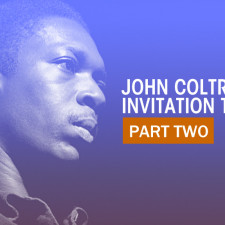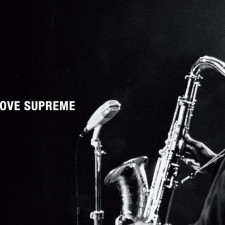ONE OF THE GREAT WORKS OF ART OF THE 20TH CENTURY OR ANY OTHER
By Justin Desmangles
One of the great works of art of the 20th century or any other, John Coltrane’s A Love Supreme stands as a monument to the revival and resurrection of the human spirit in search of freedom, self-determination, and communion with a universal, cosmic, consciousness of all creation. In Coltrane’s unique vision, God. As we celebrated its recording last year, its 50th anniversary, I was struck by what seemed almost absent in the ensuing commentaries and conversations. Love. It would seem simple enough, after all, the word itself is in the title of the work. Yet and still, there has been a dearth of explication on this issue, love, a most important and vital one. One that, if not included in discussions of John Coltrane, his life, times, and the forces leading to the creation of A Love Supreme, there can be no real understanding.
Love played Lyrically…
John Coltrane was indeed a lover. The journey of his heart’s devotion, its pain, satisfactions, joys, refusals, and finally obligations, have made our world richer, more complicated, more subtle, a paradox of his frequently profound gentleness. His tenderness as a balladeer is legendary, but to touch this legacy is also to move closer to the songs he chose to record. Grasping that tradition insists on the study of a near lost art, that of the interpretation of a song’s lyrics instrumentally. Great masters of this approach to the ballad in American popular song include other tenor saxophonists, such as Coleman Hawkins, and perhaps the greatest of them all, Lester Young. Both were formative influences on the young Coltrane, to be sure, but it is the method of elaboration on a particular story within a song that we are concerned with here. Taking Young as an example, and the now canonical recordings in collaboration with Billie Holiday, we find him employing his tenor to embroider details of the lyrics sung by Holiday, with compassion, wit, rhythm, color, and mercurial form. Impossibly delicate obligatos adorn the narration Holiday offers, a romantic ebb and flow of masculine and feminine powers at play. Hear either “This Year’s Kisses” or “A Sailboat in the Moonlight,” both recorded in 1937 for some extraordinary examples of this. Young would continue this technique in his most seminal ballad recordings, most remarkably in the stunning “These Foolish Things,” as recorded for Aladdin Records in 1945. The parallels with a religious ecstasy conveyed through this method of improvisation, that of interpreting the song lyric, can also be found vividly illustrated by both the famous 1939 recording of “Body & Soul” by the aforementioned Hawkins, arguably the most renowned tenor saxophone solo on records, as well as the only slightly less famous alto saxophone improvisation by James Moody, recorded in 1949, on “I’m in the Mood for Love,” ironically better known in its numerous vocalese versions.
Of course knowing the lyrics, what the songs are actually about, their internal illumination, is paramount here. As Young famously said, “if you don’t the words you can’t tell the story.” Granted, the writers of popular songs in this era included no shortage of poets, Cole Porter, Lorenz Hart, Johnny Mercer, among them. In fact, the impact of these writers on modernism in American poetry proper, which was tremendous, has been little examined. But that is another essay. Coltrane’s adoption of the interpretive dynamics of the Hawkins and Young approach to the ballad form is crucial in his development as an artist and the most important key to unlocking the fourth movement of A Love Supreme, Psalm, a poem written by Coltrane himself, then narrated, embroidered, adorned, and illustrated by his saxophone. The poem, printed in the liner notes of the original gate-fold lp of A Love Supreme, offers the album’s title as both prayer and supplication. This attitude, or point of view, on the essentially sacred character of earlier, secular, romantic loves in Coltrane’s own life had earlier reached its apotheosis in the composition of his most enduring ballad, “Naima,” written for his first wife.
The acceptance of love as an obligation towards joining and growth is no less present in its romantic inclination than its eventual religious trajectory. The plea for a simple return to a most basic humanity, freed of the trappings, pitfalls, and treachery of daily life with its poisonous chicanery can also be discovered in Coltrane’s improvisation on “I’m Old Fashioned,” written by Jerome Kern with lyrics by Johnny Mercer, from the album Blue Train. Recorded in 1957, the album was later cited by Coltrane as his personal favorite during a radio interview in Sweden, 1960. I will leave it to the reader to revisit the recording of this ballad, but if you didn’t know the lyrics, you’ve only heard half the song. Here they are, to read along with as you listen.
I am not such a clever one
About the latest fads
I admit I was never one
Adored by local lads
Not that I ever try to be a saint
I’m the type that they classify as quaint
I’m old fashioned
I love the moonlight
I love the old fashioned things
The sound of rain
Upon a window pane
The starry song that April sings
This year’s fancies
Are passing fancies
But sighing sighs holding hands
These my heart understands
I know I’m old fashioned
But I don’t mind it
That’s how I want to be
As long as you agree
To stay old fashioned with me
I’m old fashioned
But I don’t mind it
That’s how I want to be
As long as you agree
To stay old fashioned with me
Oh won’t you stay old fashioned with me
Oh please stay old fashioned with me
On Ritual and Revolution…
It is equally interesting to note that Coltrane’s desire to “stay old fashioned” as the song’s lyrics suggest, was later part and parcel of his rejection of jazz, indeed of music itself, as a form of recreation and entertainment. This leading directly to the attitudes and perspectives that informed the creation of A Love Supreme, and later still, his more challenging late period recordings, Ascension, Meditations, Om, Interstellar Space, et al. Recordings which, even today, remain the object of extreme controversy in the worlds of art and culture, if not also the politics and representation of black masculinity. Particularly the emerging representations of the black masculine that would accompany the transition from the civil rights struggle to the era known as that of Black Power. An era of which Coltrane, most especially by way of the poets Ted Joans, Amiri Baraka, and Michael S. Harper, has become a potent, persuasive, and powerfully charismatic symbol.
Paradoxically, Coltrane’s rejection of music as entertainment, demanding that it be sublimated entirely to ritual and its potential for magical-religious significance, in point of fact retuned jazz to its pre-recorded origins. As well, it also began a new period of openness to the influences of non-Western music, most notably those of the Middle-east, India, and the African continent. A similar roux one might have discovered in New Orleans at the turn of the century and before. Old fashioned indeed. This explosive cross pollination of fertility, joining and growth, was illustrative of the changing black world across the United States and throughout the diaspora at this time, the 1960’s. A heightened sense of cultural roots stretching back, beyond the reaches of the New World, was taking hold among the black youth of America, expressing the very continuity strived for in Coltrane’s emerging new aesthetics.
Coltrane’s soprano becomes incandescent, weaving in and out of Dolphy’s bass clarinet serpentine lines”
I would mark this turn as really occurring within the Classic Quartet (McCoy Tyner Jimmy Garrison, Elvin Jones) as augmented by the genius composer and multi-instrumentalist, Eric Dolphy. This formation can be heard most explicitly in the many recordings engineered by Rudy Van Gelder, for Impulse Records in the winter of 1961, at impresario Max Gordon’s nightclub, The Village Vanguard. Though it must be said, this new attitude, its shifts and its turns, had already begun to awaken in Coltrane during his long tenure with Miles Davis, an ardent champion of Coltrane’s experiments. Despite the consternation of critics, Davis gave Coltrane free reign to improvise at extraordinary length on stage in performance with his quintet. Proof-positive of this dramatic break, some would say traumatic break, with recreational, entertainment jazz can be found throughout the above live recordings with Dolphy, but nowhere more so than on the second version of India, recorded November 2, with the additional personnel of Garvin Bushell, oboe, Ahmed-Abdul Malik, oud, Reggie Workman, bass. Like so much of Coltrane’s music in the 1960’s, culminating with A Love Supreme, India is remarkably in tune with the changes taking place within and without black American identity. The search for a new land, as Lee Morgan would later say, was in full relief. Coltrane’s soprano becomes incandescent, weaving in and out of Dolphy’s bass clarinet serpentine lines, all set against the pulsing tapestries of sinuous melody provided by the expansive new aural possibilities of Eastern instrumentation. The continuing struggle towards what Vincent Harding rightly describes as a “deepening of American democracy,” rather than simply a civil rights movement, increasingly began to include an amplification of Black consciousness aligning itself with similar struggles throughout the African diaspora and the revolutions of the Third World against colonial imperialism. Here was its musical equivalent. Vibrant, lucid, uncompromising, it is a music of global revolution.
India marked that conceptual shift in composing Coltrane makes toward non-Western methods of organizing music. While it can be pointed out, quite rightly, that the use of modal themes began earlier in his work with Miles Davis, the album Kind of Blue, but also the composition Miles, from the earlier Milestones album, Coltrane’s pivot here is truly his own. It is, moreover, a strategy that Coltrane begins to embark on with the full force of his creative and spiritual life, one that not only marks a separation from his earlier means of organizing music, but also towards his own body, mind, and the tensions between his inner and outer worlds. As in Indian classical music, where scales, tonal centers, or modes, can represent very specific areas of human experience, a correspondence with the chakra system, Coltrane himself began to envision similar potentials in his own evolving language of artistic expression. It is this realization that plants the creative seeds of what becomes A Love Supreme, the quest for a purely spiritual music, capable of holistically integrating our body and soul with the universe in absolute peace and total harmony. It is well known that this period of rapid development in Coltrane’s musical vision was accompanied by a prodigious study on his part of philosophy. His reading was wide and varied but increasingly concerned with the religious ideas of the East, Asia and Africa most particularly. Thus, not only did the methods of composition and use of instrumentation change and vary, but the most fundamental ideas about music’s purpose, what indeed music performance, now ascribed as ritual, was for. All became equally transfigured in Coltrane’s new vision.
Justin Desmangles is Chairman of the board of directors of the Before Columbus Foundation. He is the creator of the critically acclaimed radio program, New Day Jazz, now in its thirteenth year. Described by Ishmael Reed as one of the most important young black intellectuals in America (C-Span, April 3, 2011), his poetry and journalism have appeared in Amerarcana, Black Renaissance Noire (NYU), Drumvoices Revue (SIUE), and Konch. He presently is collaborating with Roscoe Mitchell (Art Ensemble of Chicago), as librettist, for an opera on the life of poet Bob Kaufman.
Here are a few links to some of Justin Desmangles’ radio programs that are particularly relevant to this essay. These are 3 hr. programs with author interviews in the third hour. Book is italicized. Do dig Free Jazz/Black Power & F.B. Eyes: How J. Edgar Hoover’s Ghostreaders Framed African American Literature
Forthcoming Broadcast Interviews
03.08.2015 Claudia Moreno Pisano
Amiri Barka & Edward Dorn: The Collected Letters
Recent Broadcast Interviews
02.15.2015 William J. Maxwell
F.B. Eyes: How J. Edgar Hoover’s Ghostreaders Framed African American Literature
02.08.2015 Will Alexander
Towards the Primeval Lightning Field (2nd ed.)
01.18.2015 Grégory Pierrot
Free Jazz / Black Power
12.21.2014 Jeff Chang
Who We Be
Tags: a love supreme, john coltrane, Justin Desmangles


 Share On Facebook
Share On Facebook Tweet It
Tweet It






